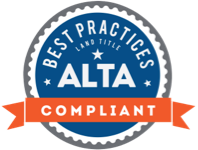How Attorneys and Loan Officers Can Translate a Quarter-Point Rate Drop Into Real Dollars and Buyer Confidence
“The Fed has lowered interest rates by a quarter point” is the lead story of the day and now your clients ask: “What does a quarter-point rate drop mean for me?” If you’ve ever tried to explain macroeconomics while juggling a time of the essence closing date, and clients who thinks they do not need title insurance, read on. Here’s how to explain what just happened, what it means in dollars and cents, and why it might be time to take another look at that preapproval letter.
What Does the Fed Control?
The Federal Reserve (aka The Fed) is America’s central bank. Its job is to keep the economy steady: not too hot (which leads to inflation) and not too cold (which leads to recession). One of the main tools it uses to regulate the economy is the federal funds rate. That is the interest rate banks charge each other to borrow money overnight. That rate trickles down and can affect every financial product you can think of…from car loans and credit cards to, potentially, even mortgages.
What’s a Quarter-Point Drop?
A quarter-point drop means the Fed lowered its benchmark rate (i.e. the standard publicly accessible interest rate) by 0.25%. While it may not sound like much, in the world of finance, even a quarter-point drop can ripple through the entire lending ecosystem. The exact impact on mortgage rates isn’t one-to-one. The Fed doesn’t set mortgage rates directly, so a quarter point reduction does not necessarily translate to an equal reduction in mortgage interest rates, but lenders often adjust their offerings in response to these moves.
Fed Rate vs. 10-Year Treasury: Why Mortgage Rates Don’t Always Match the Headlines
It is important to deal with the real meaning of these actions versus that which is reported in news updates on your iPhone, sound bites on the radio and scrolls on the bottom of your television. As discussed, the Federal Funds Rate is a short-term rate set by the Fed; it influences borrowing costs across the economy, like credit cards and adjustable-rate mortgages. But 30-year mortgage rates move more closely with the 10-Year Treasury Yield, which reflects long term investor expectations about the economy.
So when the Fed cuts rates, mortgage rates might drop but they don’t always. It depends on how the market sees the future. For buyers, that means every Fed move is a reason to check in with their lender…just don’t assume a cheaper mortgage is automatic.
What Does a Quarter Point drop in Interest Rates Mean in Dollars?
Let’s say banks respond favorably to the Fed’s rate reduction and there is a corresponding quarter point drop. Let’s break down that savings with a simple example. Suppose a buyer is borrowing $500,000 on a 30-year fixed mortgage. At a 7.00% interest the monthly principal and interest is $3,327. At 6.75% interest the monthly principal & interest is $3,243. That’s $84 per month in savings. Over 30 years that amounts to over $30,000. The true impact of the savings is shown when that same buyer takes the savings and increases their purchasing budget.
How Much More House Can a Buyer Afford?
This is where the entire real estate market feels an impact. That $84 per month translates into an additional $15,000–$20,000 in buying power, depending on other debt, income, and down payment. For some clients, that could be the difference between a starter condo and a two-bedroom with sunlight, walking distance to the train versus limited access to public transportation or simply having more breathing room in their monthly budget. And for industry professionals it’s a new way to re-energize buyers who had hit pause when rates felt too high.
What about Existing Homeowners?
If your client already owns a home, a rate drop can still matter in several ways. Perhaps the time is right to consider refinancing? At the very least, the numbers should be run to see if the cost of refinancing is justified by the amount of savings in the monthly payment. If your clients’ mortgage interest rate can be reduced by a full point, it might be time to act. HELOCs and Adjustable-Rate Mortgages are often tied to short-term rates and can go down soon after a Fed move. You should suggest your clients consider these opportunities.
Will a quarter point drop encourage placing a house on the market? A homeowner who locked in a great rate might still hesitate to sell; a small drop can shift affordability for potential buyers just enough to warrant shopping for an upgrade. And for clients sitting on equity? Lower rates can make home equity lines of credit (HELOCs) or cash-out refinances more attractive.
Why It Matters Now
Real estate doesn’t move in a vacuum. When rates dip, even slightly, it creates opportunities. Buyers who were sidelined may jump back in. Sellers may see more serious traffic. Deals that felt tight may now make sense. And buyers may feel less rate anxiety, with the right guidance. The professionals who can explain the “why” behind the headlines are the ones clients trust…and refer.
Partnering With Professionals Who Make You Look Good
At Cornerstone, we work with attorneys and loan officers who want more than a title company who works off a checklist. We bring diligent research, legal clarity, and proactive communication to every deal. You don’t have to chase us. We’re already there, helping you and your client understand what the numbers really mean.
And because the government sets title insurance rates, your clients don’t pay more to work with us but they do get more. Like fewer delays, more transparency, and a partner who understands the market as well as the paperwork.
The bottom line?
A quarter-point drop isn’t just a number. It’s an opportunity. Let’s make the most of it, together.
Written by Peter Carrozzo and Justin McCartney




